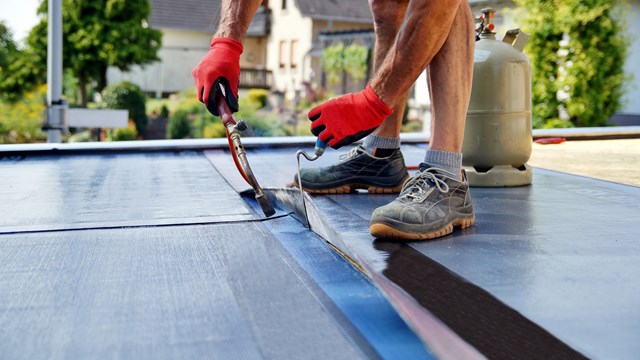
Years ago, when I babysat for a young boy, I watched him create a multi-story building out of empty cardboard boxes. The lad then ran around his proud creation, flexing his muscles and crowing, “My house is indy-structible!” (He then proceeded to crash bodily through the cardboard doors, kick the walls in and lob toys at the roof. It took him a while to destroy his structure, but he enjoyed every second of it.)
Wouldn’t it be great if your condo building or townhouse was “indestructible,” too, and could withstand the relentless forces of nature and time without needing constant maintenance and costly repairs? New Jersey’s residential buildings are tougher than my babysitting charge’s cardboard castle, but they’re not indestructible. There are several factors that can cause significant wear and tear on all buildings.
Defending Your Castle
Urban buildings may appear to be solid as rocks, but it’s very important to remember that they’re not static. Once construction is completed, buildings don’t necessarily stay put.
There really isn’t anything that can be done to protect a building from the natural shifts in the earth, or its underlying long-term effects on the structure. There are, however, other enemies that can cause damage to your building’s shield. Part of any HOA’s maintenance plan should include protecting its buildings against these enemies, repairing any damage and maintaining the building exterior on a regular basis.
Neglect can lead to worsening conditions and ultimately cause a hefty dent in a building or association’s bottom line. By staying on top of building maintenance, you are actually slowing down deterioration—and hopefully saving money. It’s important to understand that what kind of damage can occur often depends on what the building is made of. “Stone, brick, metal and wood all have drastically different life spans and tolerances,” says Frederick C. Baumert, principal of Keast & Hood Co. Structural Engineers in Philadelphia, a company that has worked on Philadelphia’s historic city hall.
For example, some building materials such as limestone may absorb dirt more than, say, granite or sandstone. However, all the experts interviewed for this article agree that all buildings have one common enemy—their kryptonite, if you will—and that’s water.
Keep it Weather Tight
Keeping a building weather-tight is the first line of defense against serious structural and property damage, but it’s not an easy job. Finding the source of a leak isn’t as simple as it sounds—and sometimes the rules of gravity don’t even seem to apply.
“Generally speaking, the source of any type of leak isn’t where it infiltrates the interior of the building—it’s often in a different spot,” says Mike Keller, of George J. Keller and Sons LLC, in Flanders. “Water takes the path of least resistance, so a lot of times water will enter the condo at a certain point, then run down a rafter or a beam. Then it might hit a nail on a beam, or a knot in the wood that it can’t pass, then gravity gets hold of it and takes it down, so that’s where you see it actually entering the building.”
Certain areas of a building are more prone to leaks than others.
“Any penetration in the roof [can be a source of leaks],” Keller says. “So if you have a pipe coming through, or a power fan or a skylight or something like that, and if you have a leak in a room that’s below one of those items, generally you can say that’s where the water is coming from.”
Jim Murphy, owner of Pro-Tec Building Restoration Services in East Hanover, says it’s common for the location of the leak to be far removed from its source.
“We’ve had situations where someone gets a leak on the second floor,” Murphy says. “So we go and check the second-floor windows, and we check the façade and everything seems OK. Then we go to the fourth floor, and that’s where the problem is—but there’s nothing happening on the third floor.”
Baumert notes that “water also causes wood to decay and brick, stone, and concrete to spall.” Spalling happens when water gets into the micro-cracks, then as it freezes and thaws again, causes deterioration and weathering.
Controlling water damage in multifamily buildings is not only vital to the buildings’ structural integrity, but it’s vital to the health of the residents and staff. Wet or damp drywall, caulking, grout, wood, or carpet in a condo or townhouse can become moldy. When the mold is disturbed, spores are released into the air. When inhaled, those spores can cause serious health damage.
Pollution and Wind Problems
Pollutants—in both airborne and rain-borne forms—are constantly showered on urban and suburban buildings. Acid rain can quickly erode stone and brick, and a thick build-up of smoggy residue and grime can trap moisture against building surfaces and hasten their deterioration.
“The second-ranked major force is wind,” says Baumert. “There is the obvious pressure and buffeting from the wind, which can be stronger at the top of a building than at the bottom, but also the materials that wind carries can be hazardous. In mild winds, the materials would be dust and dirt (sandblasting), and water (snow, rain, sleet, hail). In very strong winds, the objects may be much bigger; stones, lumber and—depending on where you live—the occasional cow,” he joked.
All humor aside, building maintenance is a serious issue. There are numerous examples of commercial exteriors and their wear and tear, causing a need for repair. Case in point: A few years ago, Cornell University announced major repairs to its exterior infrastructure, which was riddled with cracks in its concrete caused by the seasonal freezing and thawing cycle. With moisture caught in between the cracks, the damage worsened, leaving the prestigious college’s building in serious need of repair.
Fixing It Up
All the professionals interviewed for this article agree that buildings and associations should adopt and stick to a regular maintenance program rather than waiting until an emergency rears its ugly head to bring in a repair company. Far better, they say, to establish a regular maintenance program and take care of minor problems proactively, rather than waiting for them to morph into full-blown crises.
Of course, the damage done by water, wind, and other natural forces can pale in comparison to the trouble an incompetent or unethical contractor can cause an association. That’s why it’s absolutely vital that HOAs and their management teams use only licensed contractors and verify that the contractors they hire have the correct licensing insurance coverage for the work they are performing.
No matter what the field or profession, when hiring a general contractor, it’s vital for HOA managers and boards to check out their credentials and also use someone who is properly licensed.
“If you live in a townhouse or high-rise condominium building with four or more units, only a certified, licensed building contractor or general contractor is permitted to perform remodeling work,” says Ron Ridgeway, owner of Tri-State Remodeling in Delaware, and who regularly services New Jersey condos. “A residential contractor would be operating outside of his license, so that’s not allowed.” Ridgeway also reminds HOA administrators to use contractors only for the job they are trained and licensed for. To do otherwise not only risks improperly done work, but opens the door to liability issues, voided warrantees, and other headaches.
There are many factors that contribute to the maintenance and repair needs of the average suburban condo building or HOA—but with proper planning, smart budgeting, and a team of trusted professionals, your association weather any storms that may come its way.
Lisa Iannucci is a freelance writer and author living in Poughkeepsie, New York.






Leave a Comment